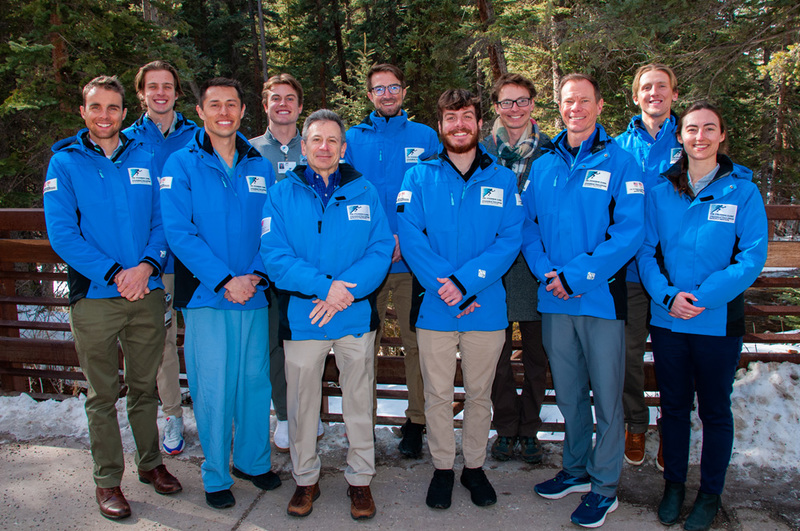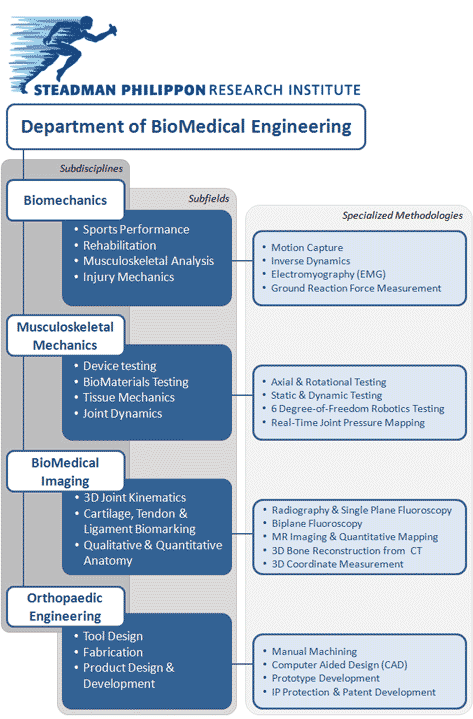BME Team: (from L to R) Justin Hollenbeck, Adam Bradshaw, Justin Brown (RA), Mitch Mologne, Scott Tashman, Colin Smith, Austin Carcia, Alex Brady, Steve Atherton, Brad Fossum (RA), Lauren Watkins.

BME Team: (from L to R) Justin Hollenbeck, Adam Bradshaw, Justin Brown (RA), Mitch Mologne, Scott Tashman, Colin Smith, Austin Carcia, Alex Brady, Steve Atherton, Brad Fossum (RA), Lauren Watkins.
SPRI’s Department of Biomedical Engineering is a collection of multidisciplinary laboratories including Biomotion, Robotics and Advanced Imaging. The team is comprised of scientists and researchers that apply quantitative, analytical and integrative methods to the field of orthopaedic medicine.
In 2021, the Department of Imaging Research officially joined the Department of Biomedical Engineering (BME), further integrating the labs and research projects. The team employs three full-time PhD researchers in Director Dr. Scott Tashman and Research Scientists Drs. Lauren Watkins and Colin Smith.
The BME team focuses on the role of mechanics and movement on injury and re-injury prevention as well as assessment of surgical and nonsurgical treatments for restoring musculoskeletal function. The team is dedicated to integrating clinical care, research and education, combining SPRI’s engineering expertise with the resources of renowned orthopaedic surgeons from The Steadman Clinic, with the ultimate goal of improving treatment of musculoskeletal diseases and orthopaedic injuries. Biomechanics, motion analysis, advanced biomedical imaging, computational modeling and orthopaedic engineering are at the center of the department’s research approach.
BME continues to collaborate closely with physicians, maintaining the imperative clinical lens that keeps its focus on high-impact research. BME’s research portfolio has expanded significantly to include an essential role in nearly all of SPRI’s clinical trials, providing advanced biomechanical and quantitative imaging assessments to evaluate the effectiveness of regenerative medicine treatments for restoring tissue health and function.
The department is home to a state-of-the-art Biomotion Laboratory for assessing human movement and function that includes video-motion analysis, an instrumented treadmill, force plates, a wireless EMG system, wearable IMU sensors, insole pressure sensors and a unique Dynamic Stereo X-ray system, utilizing cutting-edge technology designed by Dr. Scott Tashman, BME Director. Studies of musculoskeletal anatomy and new orthopaedic procedures are conducted in the department’s Robotics Laboratory, which is one of the most advanced facilities of its kind in the world. This includes a custom robotic-arm that can recreate physiological joint motion, and video-motion analysis and 3D laser scanning technologies to capture musculoskeletal geometry and function. The BME team also conducts advanced imaging with its leading-edge 3.0 Tesla Siemens MAGNETOM Skyra and Canon Vantage Galan magnetic resonance imaging (MRI) scanners in Vail, Frisco and Basalt, Colorado, while applying imaging tools to improve patient outcomes.
The SPRI Golf Sports Medicine Program operates under the Department of Biomedical Engineering, integrating a high-tech simulator system within the Biomotion Laboratory. This unique combination of technologies enables the SPRI to perform one of the most advanced biomechanical analyses of golf swings in the world, leading to a faster return to play after orthopaedic treatments, reduced injuries, and improved performance.

2017 – Cabaud Memorial Award (AOSSM)
Use of Platelet-Rich Plasma Immediately Post-injury to Accelerate Ligament Healing was not Successful in An In Vivo Animal Model
LaPrade RF, Goodrich L, Phillips J, Dornan GJ, Turnbull TL, Dahl KD, Coggins AN, Kisiday J, Frisbie D, Chahla J
2017 – Achilles Orthopaedic Sports Medicine Research Award (ISAKOS)
The Lateral Meniscus Posterior Root and Meniscofemoral Ligaments are Stabilizing Structures in the ACL Deficient Knee: A Biomechanical Study
Moatshe G, Frank JM, Brady AW, Dornan GJ, Slette EL, Coggins AN, Muckenhirn KJ, Mikula JD, Turnbull TL, LaPrade RF
2017 – Best Scientific Exhibit (AAOS)
Optimization of Tunnel Position and Orientation in Complex Multiple Knee Ligament Reconstructions: Preoperative Planning and Intraoperative Techniques
Brady AW, Chahla J, Engebretsen L, LaPrade RF, Moatshe G, Provencher MT, Slette EL, Turnbull TL
2016 – Basic Scientist Travel Grant (ESSKA)
Robotic Assessment of Anterolateral Ligament: Reconstruction of the Anterolateral and Anterior Cruciate Ligament
Dornan G, Rasmussen M, Nitri M, Williams B, Moulton S, Cruz R, Goldsmith M, LaPrade RF
2016 – Excellence in Research (AOSSM)
Anatomic Anterolateral Ligament Reconstruction of the Knee Leads to Overconstraint at any Fixation Angle
Schon JM, Moatshe G, Brady AW, Cruz RS, Chahla J, Dornan GJ, Turnbull TL, Engebretsen L, LaPrade RF
2015 - Achilles Orthopaedic Sports Medicine Research Award (ISAKOS)
Biomechanical Consequences of a Nonanatomic Posterior Medial Meniscus Root Repair After a Root Tear
LaPrade CM, Foad A, Smith SD, Turnbull TL, Dornan GJ, Engebretsen L, Wijdicks CA, LaPrade RF
2014 – Excellence in Research (AOSSM)
Posterior Cruciate Ligament Graft Fixation Angles: Biomechanical Evaluation for Single- and Double-Bundle Reconstruction
Kennedy NI, Goldsmith MT, Faucett SC, Rasmussen MT, Coatney GA, Engebretsen L, Wijdicks CA
2013 - Richard Villar Trainee Excellence in Clinical Research Award (ISHA)
The Effect of an Acetabular Labral Tear, Repair, Resection, and Reconstruction on the Hip Fluid Seal
Nepple JJ, Philippon MJ, Campbell KJ, Dornan GJ, Jansson KS, LaPrade RF, Wijdicks CA
2013 – Albert Trillat Young Investigator’s Award (ISAKOS)
Biomechanical Consequences of a Complete Radial Tear Near the Medial Meniscus Posterior Root Attachment Site: In-Situ Pullout Repair Restores Derangement of Joint Mechanics
Padalecki JR, Jansson KS, Smith SD, Dornan GJ, Pierce C, Wijdicks CA, LaPrade RF
Conference Attendance
Journals with Publications
The Education and Public Outreach Committee (EPOC) was established by SPRI to inspire the next generation of scientists through exposure to STEM (Science, Technology, Engineering, and Math). We have one of the most advanced Biomedical engineering and surgical education laboratories in the world, and our objective is to offer our Eagle County students exposure to a world-class scientific research program and hopefully light the Spark! Our SPRI team offers laboratory tours, scientific presentations, judging at local science fairs, and mentoring of student projects. With our three-tiered program, EPOC is designed to reach students from 5th grade through high school.
Three times a year, we open up our various laboratories to local 5th grade classrooms and allow them to see the important aspects of the SPRI labs used by our scientists and doctors. Students receive an interactive experience and Q&A sessions with SPRI scientists at each of the stations.
Our dedicated scientists and researchers happily visit schools for classroom or assembly lectures to inform students about the cutting-edge research taking place at SPRI. Presentations inform 6-8th grade students about the musculoskeletal system, orthopaedics, biomechanical research, and how the scientific method is applied to real world, scientific problems. SPRI researchers also participate as judges at local, middle school science fairs.
Science Club: Two students from each Eagle County high school, in grades 11-12, are selected by their respective science teachers to participate in SPRI’s high school science club under the mentorship of SPRI researchers. Teams complete two small-scale research projects during the fall semester, which introduces them to the process of planning, conducting, writing, and presenting research. In the spring semester, teams choose a unique, single project to develop and present to professional researchers, scientists, and clinicians at the end of the academic year.
Summer Scholars Program: Four students from each Eagle County high school (20 total), in grades 11-12, participate in a week-long experience while engaging with engineers, scientists, researchers, and clinicians at SPRI. This program provides hands-on activities in all of SPRI's research departments and the opportunity to learn about different careers in the medical field from professionals at The Steadman Clinic.